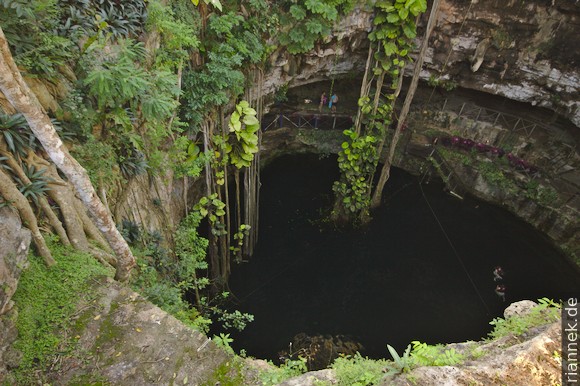
The cenotes on Yucatán are a spectacular karst phenomenon. The term goes back to the Mayan language and means “sacred well”. A cenote is (usually) a water-filled sink hole, which of course also exists elsewhere (e.g. in Croatia), but on Yucatán there are thousands of them. It is well worth visiting several, they come in all sorts of sizes, shapes and colours and with (depending on the time of day) changing light reflections. The spectrum ranges from more or less deep crater-shaped sinkholes to cave lakes with only a small well hole in the ceiling. There are shallow lakes with stalactites and tree roots hanging down from the ceiling, and deep shafts that appear to be bottomless below the water level. Still others are no more than a puddle in a grotto (and thus not a sinkhole formed by collapse of a cave).
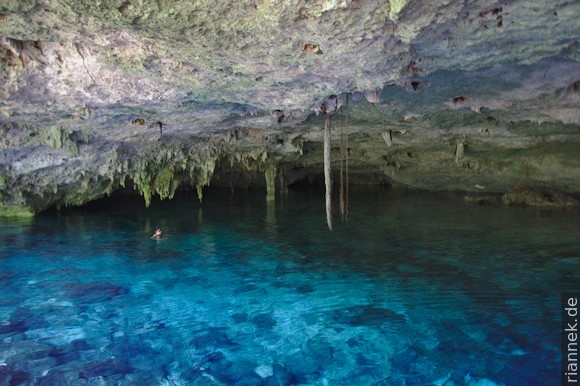
Usually they occur in clusters, each cluster corresponding to a large water-filled cave system. Some are suitable for swimming and snorkelling (a welcome cooling on a hot day), others are frequented by divers: Quite rightly, the cenotes are not an insider tip among divers, but high on the to-do list. There are cenotes that serve as wells on haciendas or in monasteries, others are hidden under a Maya pyramid; many are in the middle of the jungle, but there are also some in the middle of the city. Around some of them, various adventure attractions have been built; these amusement parks then cost a little more admission.
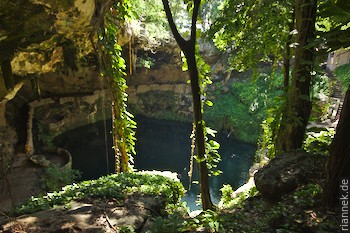
Geology of Yucatán
The Yucatán Peninsula is a geologically young carbonate platform (the recent prime example being the Bahamas), still active at the margins offshore. The limestones thus deposited in the shallow water (both biogenically and chemically through supersaturation), with the rate of deposition usually similar to the rate of subsidence due to the added weight. Part of the platform was later raised above sea level: a huge, almost completely flat peninsula. On its surface lie predominantly thick limestones of a Miocene to Pliocene (Tertiary) formation, on the coasts also Quaternary. The platform is heavily karstified, rainwater disappears into sinkholes and drains away through the cave systems. As there are no watercourses above ground, the Mayas depended on the cenotes as a drinking water reservoir. The caves are only a few metres below the surface, so it is easy for a cave roof to collapse. No wonder there are so many sinkholes here.

What cenotes have to do with dinosaurs
The headline sounds lurid. What are cenotes supposed to have to do with dinosaurs when the rocks come from a time when dinos were already extinct? Quite a lot, at least in the area around Mérida. Here, many cenotes are lined up on a semicircle with a diameter of about 200 km, but its interior contains almost no cenotes (the other half of the circle would be offshore). This is all that can be seen on the earth’s surface of a huge meteorite crater called Chicxulub, which was formed by an impact exactly at the Cretaceous-Tertiary boundary (or rather the other way around, the boundary is defined by the corresponding layer). Mérida is situated in the middle of the impact crater (the village Chicxulub north of the city is exactly the centre). Or more precisely a few hundred metres above it, because the crater is of course buried under the younger sediments. Its existance has been proven with drillings.
The impact about 65 million years ago was so violent that all over the world the rocks deposited at the Cretaceous-Tertiary boundary have a relatively high content of (in this case extraterrestrial) iridium, which was first detected in Gubbio in Italy. Microdiamonds formed during the impact have been flung as far as Canada. And above all, the climate changed abruptly, probably the main reason for the mass extinction that also spelled the end for dinosaurs. During the impact, the carbonate platform was still completely under water and younger limestones buried the crater.
The ring of cenotes was formed much later, of course. The reason is the different permeability of the rocks inside and outside the crater, even in the cover rocks. This influences the groundwater flows and thus the geometry of the karstification.
Cenotes near Tulum
The largest cluster is between Tulum, Playa del Carmen and Cobá. The Gran Cenote is only 4 km from Tulum and is justifiably popular for snorkelling. The sinkhole has a large diameter and only a shallow depth; the bright blue, crystal clear and relatively shallow water forms a ring around an island (the remains of the collapsed cave roof) where there are a few trees, lockers and the snorkelling hire shop. You can swim into a grotto with stalactites on one side, and through a tunnel on the other to a second, smaller cenote, also with an island in the middle. A visit is relatively expensive (especially as snorkel and lockers cost extra), but it’s very beautiful.
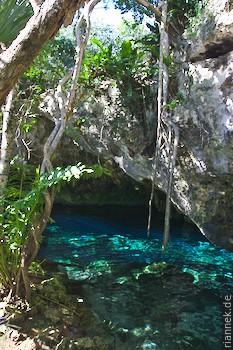
For diving, I choose the cenotes The Pit and Dos Ojos, which are usually offered in a double pack. Both are really magnificent underwater and very different. The Pit (a deep dive, i.e. you need at least “Advanced”) is an inconspicuous fissure from the outside, but a few metres below the water level it widens into a cylindrical 30 m deep shaft (a narrow area goes much deeper), in the centre of which blue glowing light beams fan out like in a laser show. The completely clear water is layered, the top with fresh water, the lower half with salt water. We sink to the bottom, where a few tree trunks lie. The deepest part is filled with a kind of fog layer, formed by the decomposition of organic material and formation of H2S. We dive into it briefly, then slowly spiral upwards, arcing into the caverns branching off to the side. Suddenly it flickers before my eyes, something like the air over the street on a hot day, except that even my own hand flickers out of focus. This is the halocline, the boundary layer between fresh and salt water, which I had barely noticed on my descent. All in all, grandiose.
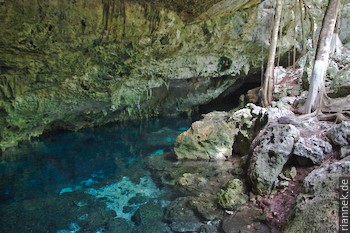
Dos Ojos (two eyes) are two cenotes next to each other, which are also popular for snorkelling. One is more like a grotto filled with a small lake, the other a wide, not deep cauldron with a crescent-shaped lake at the side. Really nice for diving is the water-filled cave in between. There are two dive routes marked with lines. It goes up and down all the time, sometimes through large caverns, sometimes narrowly through stalactites, sometimes in the dark (if you cover the lamp with your hand), sometimes in the bright blue light. And once we surface our heads out of the water and we are in a small chamber with stalactites, bats and a square-metre-sized well hole in the ceiling.
Aktun Chen is one of those overpriced theme parks, complete with mini zoo, jungle trekking and zipline through the treetops (everything costs extra). The entrance is halfway between Tulum and Playa del Carmen and the turn off is easily reached by colectivo, where you first have to wait for transport to the reception (about 3 km of dusty dirt road). Aktun Chen itself is an exceptionally dry cave, quite pretty if it were not so expensive. Interesting are the many tree roots that extend in thick bundles from the roof to the floor, reminding how thin the cave roof is. The highlight is a cave lake just before the exit, with many dripstones hanging over it. It looks uniquely beautiful in the publicity photos, but in my case the water was not blue, but covered with a layer of dust and leaves.
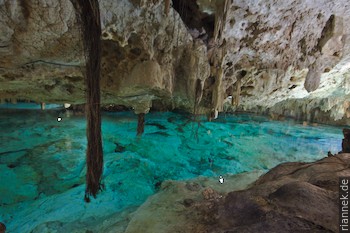
After waiting some more, I am taken to another cenote for snorkelling. This one is really beautiful, clear blue water, many stalactites and columns. However, there is no underground river as advertised, what is meant is a course between the stalactites in the cenote. (There are indeed underground rivers in other theme parks in the area, and of course in other caves around the world). Snorkel and mask are included in the price, so I found the price OK (similar to Grand Cenote). Of course, I had to wait again for transport to the reception and on to the road (in total almost 90 min).
Cenotes near Valladolid und Chichén Itzá
In the interior of the peninsular, the water table is lower than near the coast, so the cenotes look very different.
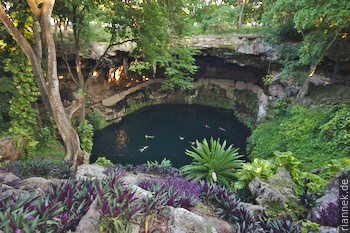
Cenote Zaki is located in the middle of the city of Valladolid and is a kind of public swimming pool. It is cauldron-shaped, very large and much deeper than the cenotes at Tulum, with part of the cave roof still in place. On the other side, the wall is less steep and full of vegetation. The water is partly more than 100 m deep, the bottom is not visible.
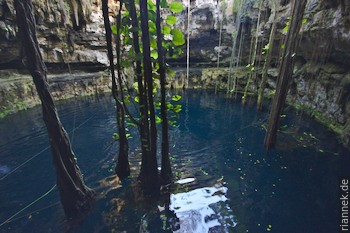
A deep gloomy circular shaft is the Cenote Oxman on the Hacienda San Lorenzo Oxman, about 3 km outside Valladolid. Despite its depth, the roots of the trees growing on the rim hang surprisingly down into the water. Access is via a concrete staircase in a narrow shaft next to it. At the bottom, you can swing towards the centre with a rope and jump into the water. The clear water was almost black (without direct sunlight) and the bottom not visible. Very beautiful.
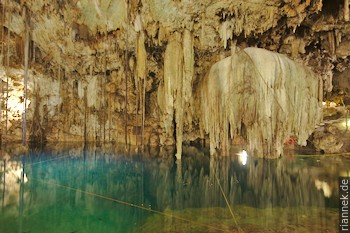
The two very beautiful cenotes of Dzitnub are very close to Oxmal as the crow flies, but can be reached via another road. Cenote X’Kekén is a beautiful cave lake with blue and relatively shallow water and some dripstones, there is only a small well hole at the top. The neighbouring Cenote Samulá is more like a church dome, with an opening at the highest point. The water is blue and not very deep. Both are very worth seeing.
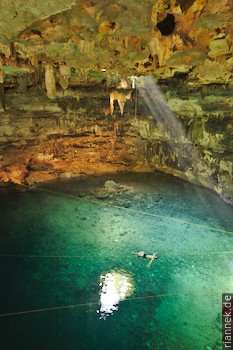
Half an hour’s drive from Valladolid is the Mayan ruin of Ek’Balam, from where you can reach Cenote X’Canché in 1.5 km on foot or by bike. This is again a round shaft (less deep, less narrow than Oxman and not as murky), again with roots hanging down. Access is via airy wooden steps and walkways. Very beautiful.
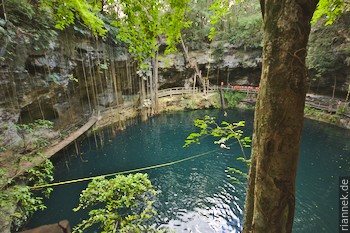
The Cenote Sagrado (Sacred Cenote) in Chichén Itzá is also a circular cauldron with vertical walls, but with a larger diameter and therefore not so shaft-shaped. The water is full of algae, which is because archaeologists once tried in vain to drain it to make it easier to dig for offerings.
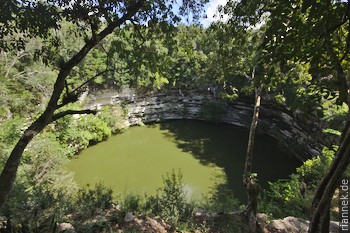
The cenote Xtoloc in Chichén Itzá is less spectacular, more like a lake in a wooded hollow. Other cenotes are hidden under the tomb of the high priest and (what geophysicists recently discovered with ground penetrating radar) also under the great pyramid El Castillo.
About 2.5 km from the entrance to Chichén Itzá, directly on the road to Valladolid, is the touristic cenote Ik’Kil. It resembles Oxman and X’Canché: shaft-shaped and with tree roots, but part of the roof is still there. Only unfortunately, almost half of the side wall is concrete, for whatever reason. And as soon as the first group emerges, the pump is turned on and two artificial mini-waterfalls trickle down from the sides. Disappointing, completely overrated.
Read on
The Formation of Mountains
From Cancun to Mexico City
Chiapas
El Chichón
Yucatán
Modro Jezero (Blue Lake) and Crveno Jezero (Red Lake)